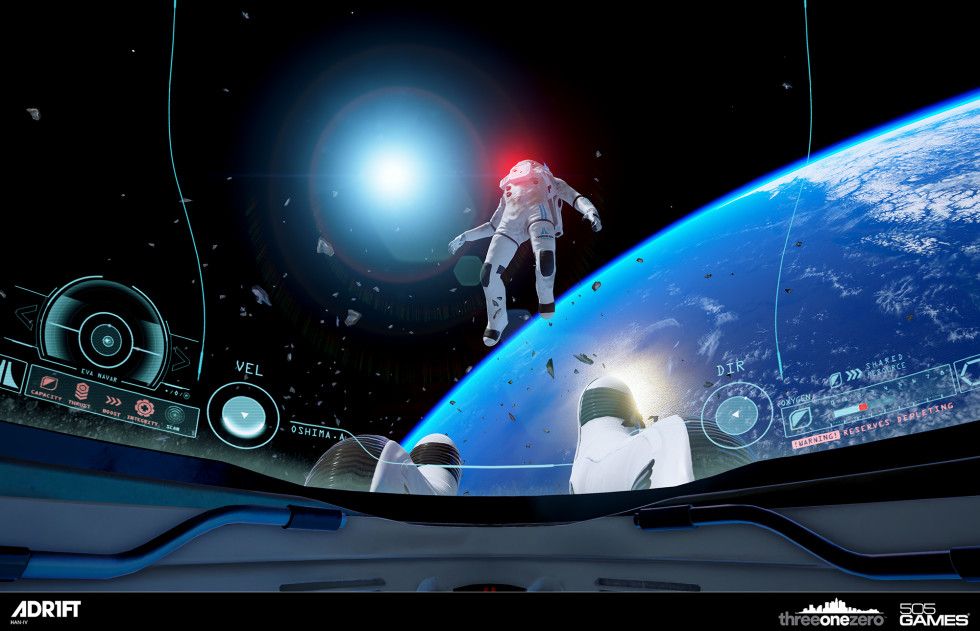Developer ThreeZeroOne recently held an AMA on the Oculus Subreddit with Technical Director and Co-Founder Omar Aziz. Previously Aziz was a contributor for Activision and EA, having worked on the Call of Duty: Black Ops series most notably.
His new game ADR1FT releases tomorrow, March 28, 2016 for Oculus Rift, and to help promote the Oculus and the game participated in the following AMA.
When asked about a separate free roam mode that would release players from worrying about their oxygen supply and simply enjoy the views in VR Aziz was hopeful that it would be added.
We have discussed [free roam mode] before and the team is definitely into something like that. We just couldn't fix it in. We're definitely considering it for a future update.
Aziz also went into how optimization changed with different versions of the Oculus headset.
We had to approach graphics optimization from the start. When we started the DK2 requirement was 75hz. We already though that was going to be difficult. When we got our hands on the Crescent Bay and started to think about 90hz we knew we had our work cut out for us. It really about pulling out all the tricks and finding all the "fast paths" through Unreal Engine. We made some of our own customizations to the engine as well.
Asked about the size of the development team, Aziz confirmed it was never more than fifteen people working on the game at a time.
The core team at TOZ is 7 people. We had up to about 15 max at any one time. All in all we build this with a persistent skeleton crew. We were able to accomplish quite a bit. Was it weird? Hell yeah it was...it was on a team of 200+ people. We had at least 40 engineers. We had 2-4 on ADR1FT at any one time.
ADR1FT doesn't feature room tracking, and won't in any future update due to the difficulty.
Good question! We are still a video game and we don't support room space tracking. Also one thing to remember is that the traditional character setup in a game is not to have the camera has the "root" object. So turning your head and expecting your avatar to move to requires an actual hierarchy change that goes against many years of videogame development. In ADR1FT we let you turn around 360 inside the helmet. Yeah that sounds weird buts its really not too much because we keep your immediate attention forward. When you step too far away from where the tracker thinks you are we reset the frame of reference. Its a simple solution. ADR1FT is best played in a chair but works standing as well. Room space tracking was just something that didn't fit in the game.
He also gave advice on using the Unreal Engine, as well as the total size of the final product in both compressed and uncompressed formats.
Thanks for the questions:
-
Definitely have lots of tips and tricks! The biggest thing is to think about having really cheap pixels. Rendering to the rift is like having a giant backbuffer. All those extra pixels have a cost and its up to you to balance it out. Dont be afraid to take out a fancy postprocess effect that you're in love with. Build nice clean content from the start.
-
We are using Unreal Engines deferred shading renderer. Its beautiful and it works great.
-
Absolutely! We have a few things cooking as we speak.
-
We use a tiered lighting system. We have a baked sun light with cascaded shadows maps. In the interiors we use a combo of stationary (baked/dynamic combo) and movable (dynamic only) and static (only baked). We did a lot of tests to figure out what the right balance was. We learned A LOT about Unreals lighting system.
-
The game is about 1.8GB compressed. About 6GB uncompressed
The game is another short experience for VR users, lasting about four hours total.
ADR1FT is about a 4 hour long experience. There's a lot of exploration to do but the main path story is roughly that long.
Aziz doesn't rule out touch controllers for the Oculus, but currently have no plans to support.
Unfortunately we do not support touch controllers at launch. We would consider it but I think it would end up being pretty difficult. The game was long in development before the existence of the touch controllers. Using touch really takes a different approach to player arms/body.
Lastly, Aziz gives a brief timeline of the beginning of ADR1FT's development.
Adam and I started in October on 2013 on our prototype. We signed the deal in February and started in April 2014 on the full game. Almost 2 full real years at this point.

